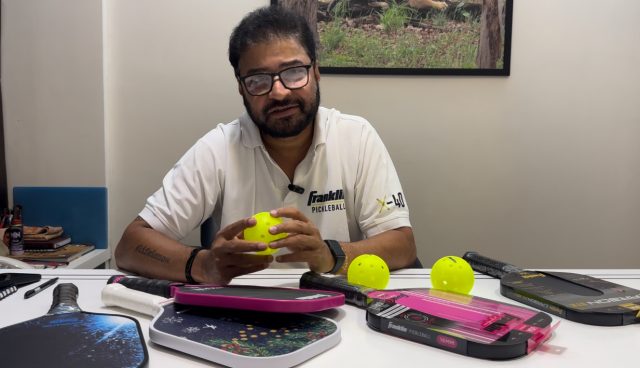From wooden to fibre glass and carbon fibre- the six-decade evolution of Pickleball paddles has been massive. Manish Rao, the Director of Franklin India, shares his view on this huge change in Pickleball paddle market both at the national and international level.
From Wooden to Composite Pickleball Paddles
Manish Rao: Pickleball started in the 1960s at Bainbridge Island and till 1980s there were all wooden paddles. Then a gentleman named Arlen Paranto first thought of making composite paddles. As he was a Boeing Industrial Engineer, he knew about a material called honeycomb used in commercial airlines. He took that honeycomb material and sandwiched it between the surface. And, thus, composite pickleball paddles came into existence.
From Fibre Glass to Carbon Fibre Pickleball Paddles
Manish Rao: Fibre glass surfaced Pickleball paddles have a lot of strokes. But they do not grip the ball much because the surface is skiddy. So now the manufacturers are going for carbon fibre for the surface. The carbon fibre surfaced Pickleball paddles have got more traction and the balls stick to the surface a little longer.
It is amazing that the manufacturers are continuously in search of a better technology. From raw carbon fibre some manufacturers are now using the latest T700 carbon fibre. This further increases the control and grit on the paddle and the players can generate more spin. So, in this way, the game is having a lot more backhand spin, forehand spin and so on.
The Standardization
Manish Rao: Yes, as per the specifications of the United States Amateur Pickleball Association (USAPA), a paddle has to be of 24 square inch and cannot exceed than that. If the length is 20 inch, the face has to be only 4 inch. It can be some other way also, but not more than 24 square inch.
But they have not specified the thickness of the paddle. In 2013-14, paddles were 12mm or 13mm. And then the manufacturers realized that they could experiment with 14mm 16mm or 17mm thickness. Now the thickness of Pickleball paddles have gone upto 20mm. It all depends on the players, some players like paddle which is thick, some players like paddle which is thin. Thinner core paddle will give you more power and a thicker paddle will give more control. Its all about personal choice and is totally legal.
Stepping of Composite Paddles in Indian Market
Manish Rao: I started playing Pickleball with wooden paddles. During that time there was a slight kind of restriction in India about using other paddles. And at the same time we were not so aware about the international market. First time I saw a composite paddle was when my good friend Atul Edward came down with such kind of a paddle. And I felt the huge difference.
The wooden paddles were heavy, almost 300-400gms and it was just a flat surface where we could hit the ball. The composite paddle was only 200 gms or even lesser than that.
Then I went to US and contacted Paddletek to manufacture some paddles for us. That’s how the journey of composite paddle started in India.
Multiple Foreign Brands in Indian Market
Manish Rao: Unfortunately, the Paddletek paddles were not USAPA approved. We had lot of problems with those paddles. Then Prolite came in 2016. There was influx of USAPA Prolite approved paddles. However, the vision of the company towards Indian market was not a broad-minded vision and Prolite disappeared from Indian market. Then Selkirk entered; the company gave a lot of support to India and remained a market leader here for some years.
Coming to Franklin- this company has been manufacturing X40 balls for many years. They were supporting India by sending free balls during tournaments and also to many Pickleball centres. But they came to India with paddles last year. And since then, we have been doing well with sales, exposure, tournaments etc.
The Indian Manufacturers
Manish Rao: Yes, there are definitely some who are doing well. But we should all remember that the quality of Indian players have gone to the roof and we have to provide them a weapon that suits their game.
If the Indian manufactures want to compete with international brands, they have to take care of the quality. In order to provide cheaper paddles, they should not compromise with the quality. They also have to be at par with the newer technology evolving daily in international market. Another constrain for the Indian manufacturers are the accessibility of good quality honeycomb in India. And definitely there are a lot of challenges faced due to the easy availability of Chinese Pickleball paddles here. If the Indian manufacturers can overcome these difficulties then obviously they also can play a very important role in the history of evolution of Pickleball paddles.
The Evolution of Pickleball in Broader Perspective
Manish Rao: Most of us, when we started, it was only a recreational sport. But today what I see is that this sport has become a very competitive one. I used to like the recreational part. But with the competitiveness this game has grown so much. There are so many corporate involved, so many world tournaments coming to India. So I see a very very different Pickleball that we have seen 10 years back.
I am not saying that this is bad, it is a part of the evolution of sport.




